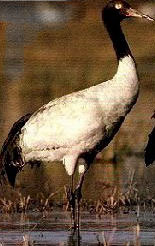Dr.Susan Sharma
 Of the 15 crane species in the world the Black necked crane (Grus nigricollis ) is one of the world's most threatened cranes. Discovered relatively recently in 1876, by the Russian naturalist / explorer, Count Prezhwalski,
this bird has an exclusive distributional breeding range between the altitudes of 3500 meters to 5500 meters in the tablelands of Central Asia. Its migratory patterns are equally unique. Cranes have been recorded from eastern Ladakh, southern Tibet, Bhutan,
Arunachal Pradesh to Szechwan, Yunan and vietnam
Of the 15 crane species in the world the Black necked crane (Grus nigricollis ) is one of the world's most threatened cranes. Discovered relatively recently in 1876, by the Russian naturalist / explorer, Count Prezhwalski,
this bird has an exclusive distributional breeding range between the altitudes of 3500 meters to 5500 meters in the tablelands of Central Asia. Its migratory patterns are equally unique. Cranes have been recorded from eastern Ladakh, southern Tibet, Bhutan,
Arunachal Pradesh to Szechwan, Yunan and vietnam
Biologically, everything about the crane group, Gruidae, seems to indicate that the birds are of very old origin having appeared on earth some 60 million years before man. Now, probably, they are on their way out. They are not
found in abundance anywhere except in several Buddhist countries like Japan and Korea, where they receive socio-religious protection. Small groups of cranes do exist elsewhere in Asia, Europe, Africa, North America and Australia, but nowhere in South America,
the Malayan archipelago, Pacific Islands or New Zealand. Most species of cranes are migratory and some of them travel great distances each year. As for the black-necked crane, it chooses to migrate to higher altitudes to nest.
The cranes are famous for their spectacular and beautiful dances in which they bow, leap into air and toss vegetation about whilst uttering loud bugling calls.
Bhutan is an important wintering ground for the stately Black necked cranes,. Each year, Phobjikha valley plays host to more than 230 threatened cranes. They stay in the valley until around the first week of March foraging for
bamboo tuber, insects, grains etc.